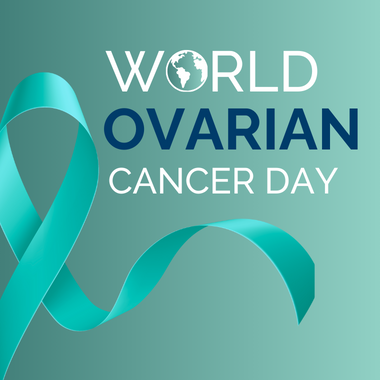This 8th of may 2025, we once again celebrate World Ovarian Cancer day with the theme, #NoWomanLeftBehind calling for the radical boosting of awareness of the disease dubbed “silent killer” due to its vague symptoms.
Ovarian cancer is a type of malignant tumor (one that spreads) that originates in one or both ovaries.It is a global health concern that presents as the 18th most common cancer in the world and the 8th most common cancer that affects women, according to the world cancer resource fund (WCRF). It is now the 5th leading cause of cancer-related deaths among women in United States. In Nigeria, according to the National institute of Health( NIH), it is the 2nd most common and deadliest gynecological malignancy.
In 2022, about 324, 603 new cases of ovarian cancer were reported by WCRF, with China( 61,060), India(47,333) and the US ( 21,179) having the highest numbers respectively.
Signs and symptoms of ovarian cancer
In the past, these symptoms were not indicative of ovarian cancer to the women because of their unspecified nature. This has lead to an increased lethality of ovarian cancer. They include:
- Abdominal bloating or swelling
- Pelvic or abdominal pain
- Loss of appetite
- Early satiety
- Constipation
- Nausea
- Urinary tenesmus (urgency to urinate with or without the action) and frequency.
- Fatigue
- Weight loss.
The essential criteria for diagnosing ovarian cancer would be the frequency of the presenting symptoms i.e their presence on a daily basis for more than 2 to 3 weeks raises the suspicion of ovarian cancer. Early diagnosis and treatment makes up for a good prognosis of ovarian cancer.
Types of Ovarian cancer
3 types of Ovarian cancer arise from 3 types of tissues:
- Epithelial ovarian cancer which arises from the epithelial cells of the ovary (cells covering the surface). This is the most common and it’s subtypes include serous carcinoma and mucinous carcinoma.
- Stromal tumors growing from the stromal (connective tissue, hormone producing) cells of the ovary due to genetic disruption. They happen to be one of the tumors that can be diagnosed at an early stage.
- Germ cell tumors which arise from the germ cells. Germ cells are cells that become eggs. Germ cell tumors tend to occur in younger females. However, it is mostly benign and cases of malignancy can be easily treated.
Causes and risk Factors
Several factors can influence a woman’s risk of developing ovarian cancer. They include:
- Family history and inherited gene changes: About 5 to 10% of ovarian cancers are due to genetics. Women who have a family history of ovarian, breast and bowel cancer suffer the risk of developing ovarian cancer. The presence of certain genes also poses a higher risk.
- High Body mass index (BMI): Women with a BMI of 30 and above (overweight and obese) are also susceptible.
- Use of Hormonal replacement therapy (HRT): The use of HRT by postmenopausal women increases their risk of having ovarian cancer.
- Age: Older women have higher risks of developing ovarian cancer.
- Number of menstrual cycles: Women with higher number of cycles e.g those with early onset (before 12yrs) and those with late menopause (55yrs and above), have a high risk of having ovarian cancer.
- Nil cyesis: Older women who haven’t been pregnant before have a higher probability of developing it.
- Smoking : Women who smoke tobacco are at the risk of developing cancers, including ovarian cancer.
Stages
The stage is determined by a professional to know how far the cancer has spread and include
- Localized: Here, the cancer cells are within the ovaries. They haven’t invaded nearby tissues.
- Regional: The cancer cells have begun to invade nearby tissues e.g uterus, fallopian tubes, etc.
- Distant: At this stage, the cancer cells have spread to distant organs like the liver, kidney, lungs, etc.
The knowledge of these stages help oncologists with the administration of the appropriate therapeutic procedures.
Treatment
The treatment options can be surgery e.g. oophorectomy, hysterectomy or tubal ligation, radiation therapy, chemotherapy, targeted therapy and immunotherapy/biotherapy (boosting of the immune system to combat cancer cells). With the treatment options available, the survival rate of ovarian cancer is 6.3% per 100,000 people, according to the National cancer institute.
Prevention
There are no known means of preventing ovarian cancer, however, certain measures can be put in place to reduce the associated risk factors. These measures are:
- Use of contraceptive pills as directed by a physician for a few years.
- Pregnancy: a woman’s risk of developing ovarian cancer reduces when she becomes pregnant.
- Quitting smoking
- Ensuring a healthy and a balanced diet.
- Consulting a genetic counsellor for early measures to avert ovarian cancer if there’s a family history of it.
- Breastfeeding.
- Maintaining a healthy weight.
Conclusion
Although Ovarain cancer is often referred to as “silent”, it really isn’t but has vague symptoms which make early detection difficult. Women must listen to their bodies in order to recognise the disease. As we say #NoWomanLeftBehind this year, we advocate for women everywhere to be empowered with knowledge about this disease. And through contibued education, the statistics can be changed for the better.
References
https://www.wcrf.org/preventing-cancer/cancer-types/ovarian-cancer/
https://www.cancer.org.au/cancer-information/types-of-cancer/ovarian-cancer
https://www.nhs.uk/conditions/ovarian-cancer/
https://www.medicalnewstoday.com/articles/159675
https://pmc.ncbi.nlm.nih.gov/articles/PMC7325817/
Victoria Aladi

